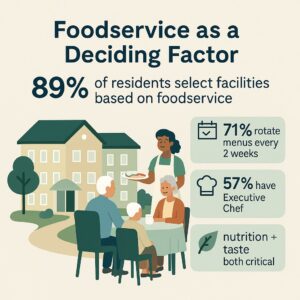
By 2025, senior living foodservice—including independent living, assisted living, and long-term care—represents nearly $7 billion in operator purchases. For food manufacturers, this segment is not simply another institutional channel. It is a proving ground where nutrition science, culinary creativity, and cost management collide under extraordinary scrutiny from residents, families, and regulators.
Taste and Nutrition: The Dual Imperative
In FSIP’s last study (2022), operators emphasized that resident demand had shifted away from “nutrition versus taste” toward “nutrition and taste.” The pandemic amplified the desire for comfort food, but health remained paramount. Facilities reported pressure to deliver flavorful, familiar options while also meeting dietetic requirements and wellness expectations. For manufacturers, the implication is clear: innovation must exceed guidelines while delivering indulgence and comfort.
Staffing and Operational Realities
Our 2022 findings showed that more than half of facilities (57%) employed an executive chef, and nearly two-thirds (62%) employed a dietician. Yet even with these resources, the majority reported being understaffed, with long-term and rehab centers the hardest hit. This has two implications for suppliers:
- Simplicity matters. Products that streamline preparation or reduce labor intensity are highly valued.
- Support services count. Operators place importance on supplier integrity, dietetics expertise, and direct support—beyond price alone.
Manufacturers that position themselves as partners in solving staffing challenges—through labor-saving formats, training, or menu inspiration—stand to gain loyalty.
Budgets and Menu Economics
In 2022, senior living facilities targeted $17 per resident per day for meals, with independent living trending higher at $21. Three-quarters of communities included all meals in the resident fee, leaving little room for cost recovery. At the same time, 52% of operators reported purchasing premium products regularly, especially in independent living (71%). This duality creates opportunities for tiered product strategies: value-engineered solutions for baseline menus, paired with specialty SKUs for high-visibility dining occasions.
The Demand for Variety
Our 2022 study found that nearly 71% of senior living operators rotated menus every two weeks—far more frequently than restaurants. More than 80% reported they were “always” seeking new products and recipes. This relentless pursuit of variety underscores the opportunity for manufacturers to inject novelty through seasonal offerings, international flavors, or functional ingredients.
Strategic Considerations for Manufacturers
Several lessons from the last study still resonate today:
- Foodservice as a differentiator. Nearly nine in ten residents considered food a deciding factor when selecting a community.
- Innovation under constraints. Culinary variety and premium offerings exist alongside budget and staffing pressures.
- Partnership expectations. Operators expected more than commodity supply—they sought insights, dietetic expertise, and menu inspiration rooted in restaurant trends and consumer culture.
Looking Ahead
These insights stem from FSIP’s 2022 Senior Living Foodservice Study. As the market has evolved, we are now launching our 2026 Senior Living Foodservice Study, which will update these figures and provide a sharper focus on how food manufacturers can navigate this $7 billion market. Sponsorship opportunities are open now, offering exclusive access to updated data and operator perspectives on menu innovation, purchasing strategies, and evolving expectations.
For suppliers, the takeaway is clear: senior living foodservice is not simply a downstream outlet for products—it is a strategically important channel where the stakes are rising. Success will come to those who treat this segment as a laboratory for innovation, partnership, and long-term growth.
To learn more about FSIP’s Management Consulting Practice, click here.
Like the content? Sign up to receive our communications.
Recent Comments